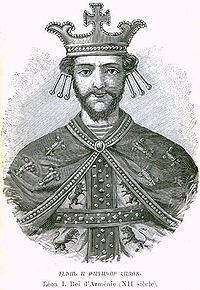Leo I King of Armenia Royalty
Leo II (Armenian: Լեւոն Ա Մեծագործ, Levon A Metsagorts), also Leon II, Levon II or Lewon II (1150 – 2 May 1219) was the tenth lord of Armenian Cilicia or “Lord of the Mountains” (1187–1198/1199), and the first king of Armenian Cilicia (sometimes as Levon I the Magnificent or Lewon I) (1198/1199–1219).During his reign, Leo succeeded in establishing Cilician Armenia as a powerful and a unified Christian state, and his pre-eminence in the political arena cannot be overestimated. He eagerly supplied the armies of the Third Crusade with provisions, guides, pack animals and all manner of aid, besides pledging the cooperation of his army. Under his rule, Armenian power was at its apogee: his kingdom extended from Isauria to the Amanus Mountains (now Nur Mountains in Turkey).In 1194–1195, when he was planning to get the title of king, he instituted a union of the Armenian church with Rome. With the signing of the Act of Union, his coronation proceeded without delay. He was consecrated as king on 6 January 1198 or 1199, in the Church of Holy Wisdom at Tarsus.His accession to the throne of Cilicia as its first Armenian monarch heralded into reality not merely an official end to Cilicia’s shadowy umbilical connection to the Byzantine Empire, but also a new era of ecclesiastical co-operation with the West. A skilled diplomat and wise politician, Leo established useful alliances with many of the contemporary rulers; he also gained the friendship and support of the Hospitallers and the Teutonic Knights by granting considerable territories to them.No doubt, he envisioned annexing the Principality of Antioch to his kingdom thus reinforcing his authority along much of the northeastern Mediterranean coastline. He had first put this plan into action in 1194 by seizing the strategic fortress of Baghras after Saladin, the Sultan of Egypt and Syria, had abandoned it. His greatest triumph was achieved at the beginning of 1216 when at the head of his army he occupied Antioch and installed his grandnephew, Raymond-Roupen as its head. Raymond-Roupen remained in power until Leo’s death.Leo was a valiant and learned prince; he enlarged his principality and became the master of many provinces. A few days only after his taking possession of the country, the descendants of Ismael, under the command of one Roustam, advanced and came against Cilicia. Leo was not frightened, but confiding in God, who destroyed Sanacherib, he vanquished with a few men the great army of the infidels. Roustam himself being killed by St. George, the whole Hagarenian army then fled and dispersed; the Armenians pursued them and enriched themselves by the booty. The power of Leo thus increased, and being confident in his strength, he chased the Tadjiks (name used by Armenian chroniclers to designate the Saracens, particularly the Seljuks) and pursued the Turks; he conquered Isauria and came as far as Iconium (today Konya in Turkey); he captured Heraclea, and again gave it up for a large ransom; he blockaded Caesarea (now Kayseri in Turkey), and had nearly taken it; he made a treaty with the Sultan of Iconium, and received a large sum of money from him; he surrounded Cilicia on every side with forts and castles; he built a new church called Agner, and was exceedingly generous to all monasteries erected by his ancestors; his bounty extended itself even to the leprous; they being shunned by everybody and expelled from every place, he assigned to them a particular house, and provided them with necessaries. The transforming of the Armenian court, following the pattern of the Frankish courts, proceeded at a more rapid pace after Leo came to power. Many of the old names of specific functions or the titles of dignitaries were replaced by Latin ones and the changes in nomenclature were often accompanied by changes in the character of these offices.Commerce was greatly developed during the reign of Leo: he granted charters regarding trade and commercial privileges to Genoa, Venice and Pisa. These charters provided their holders with special tax exemptions in exchange for their merchandising trade. They encouraged the establishment of Italian merchant communities in Tarsus, Adana and Mamistra, and became a large source of revenue for the growth and development of Cilician Armenia.He was a benevolent, ingenuous man without a grudge toward anyone, who took his refuge in God and guided his principality accordingly. He was a wise, brilliant man, a skilled horseman, brave-hearted in battle, with attention to human and divine charity, energetic and happy of countenance.
Search
Royalty
| From | 1198 |
|---|---|
| To | 1219 |
| successor |
